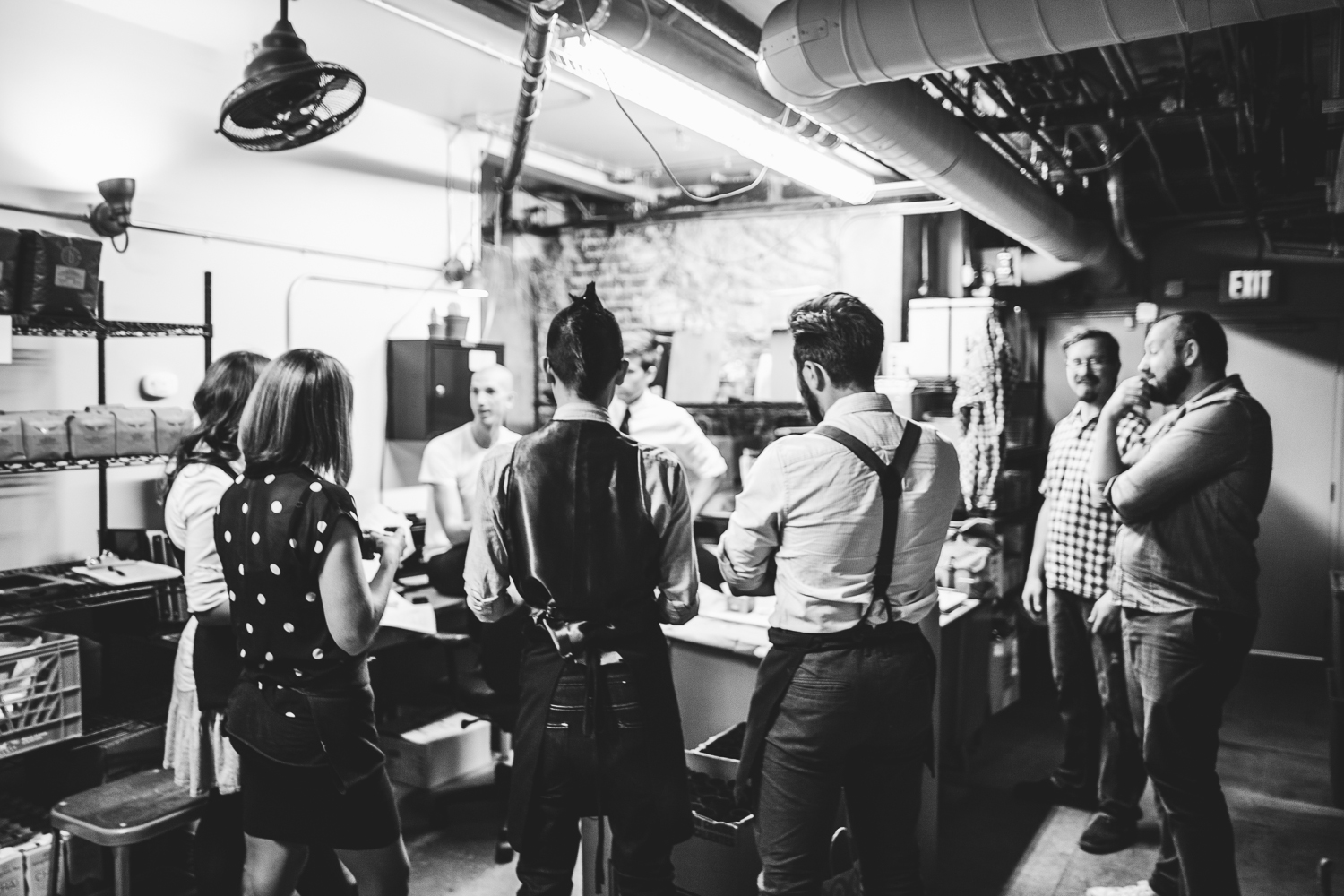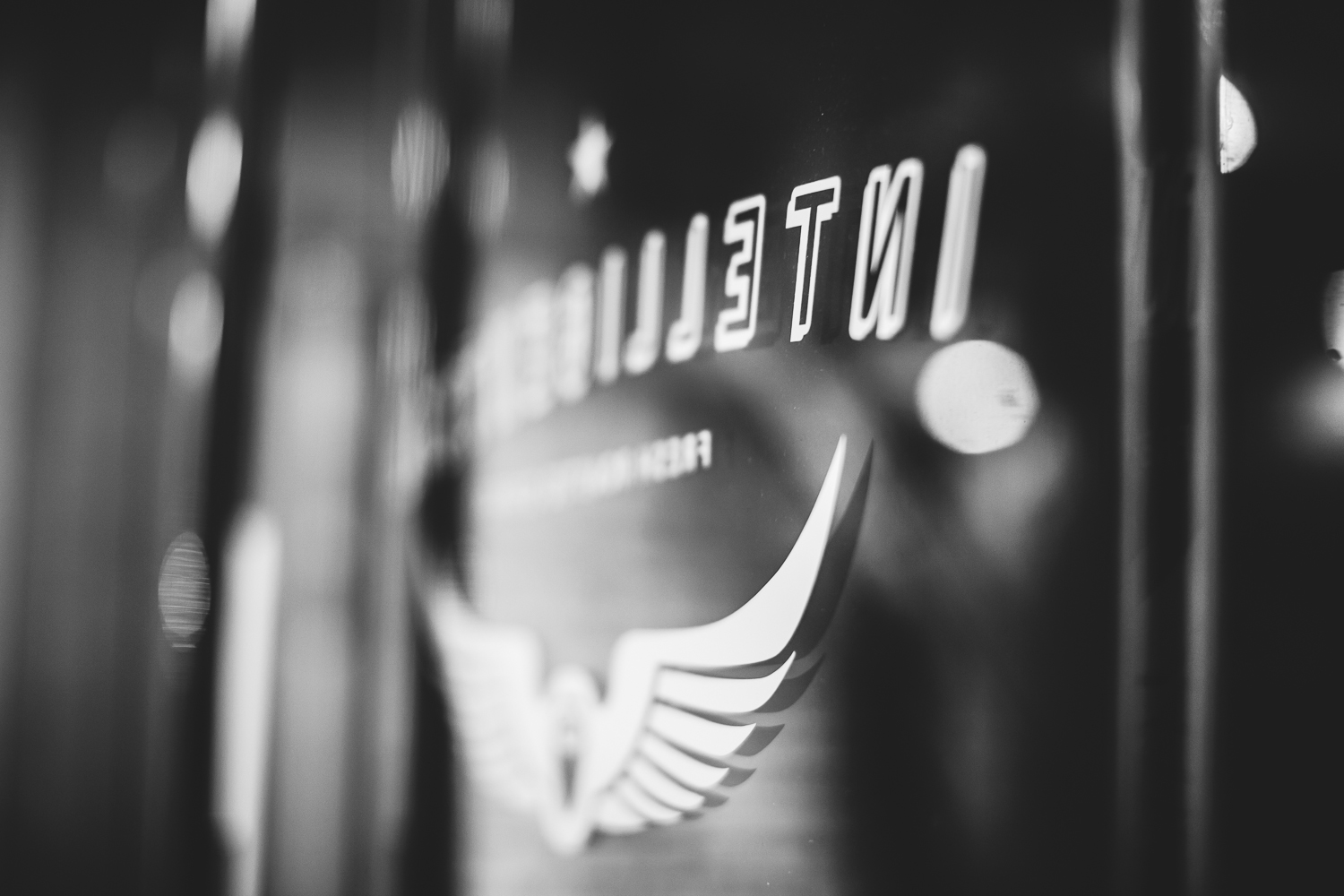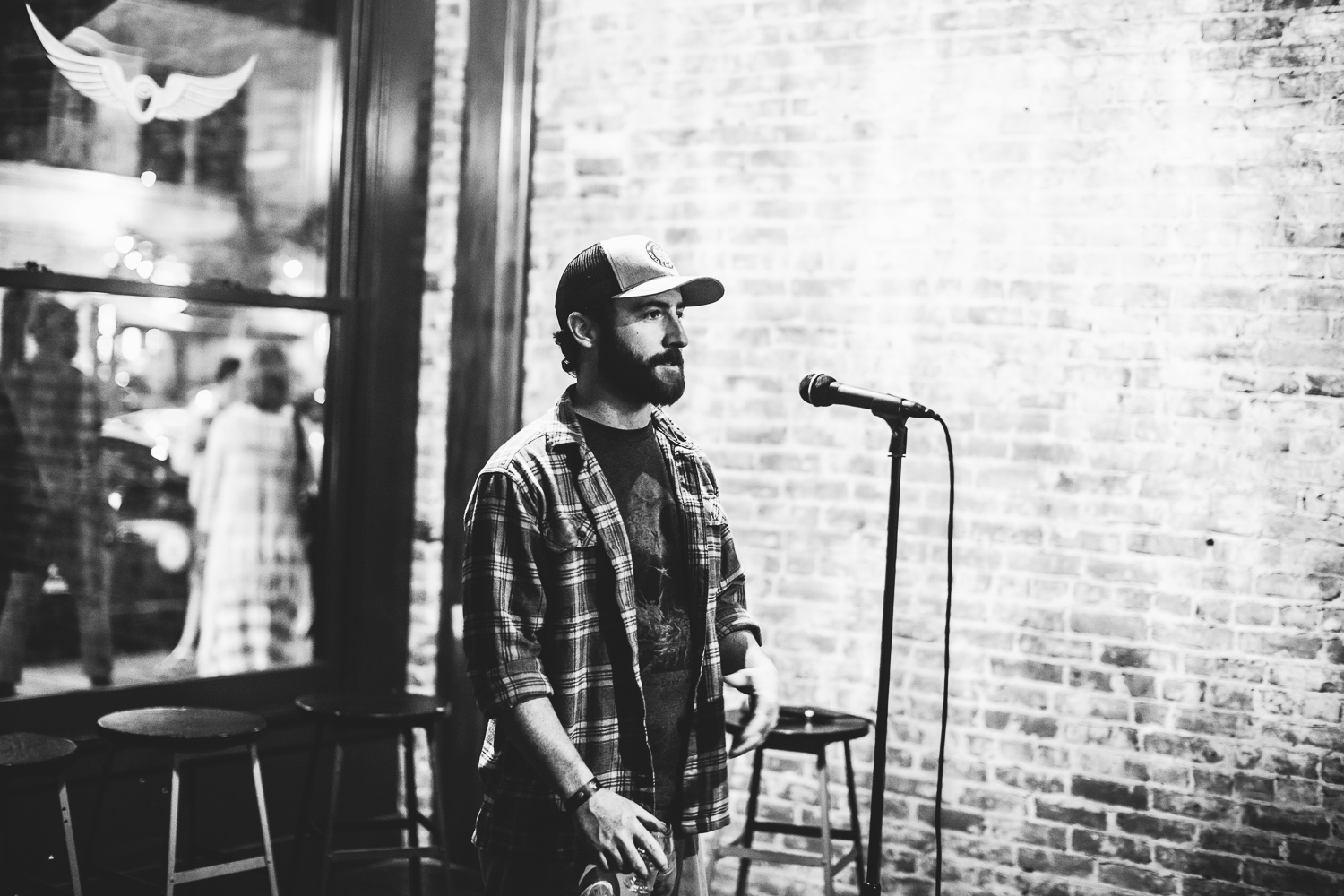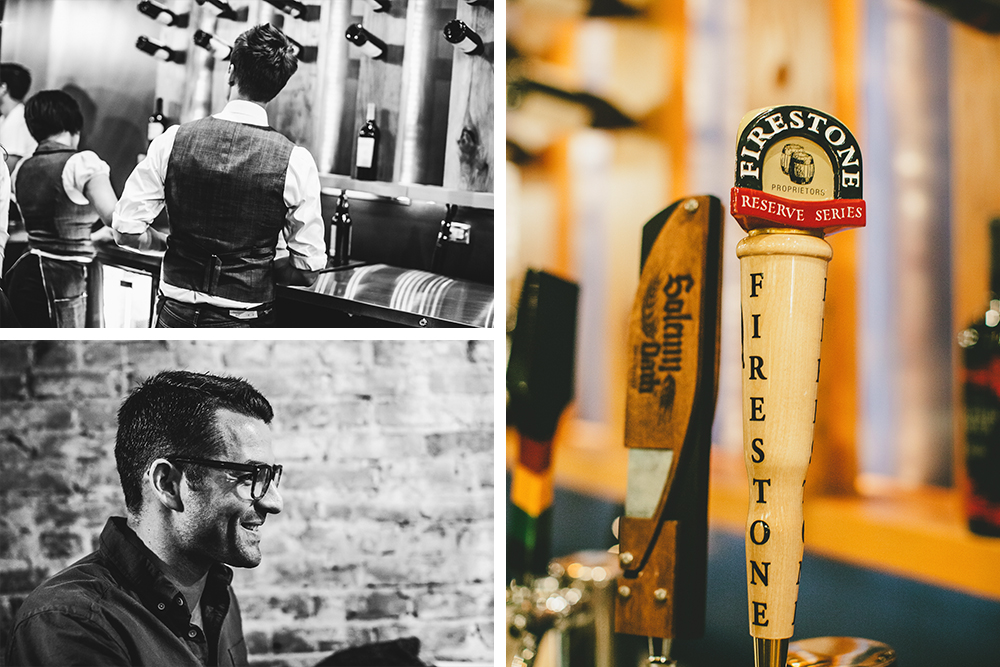Coffee beers. Chances are when you hear that phrase, a very specific image comes to mind — the dark, roasty porters and stouts that have defined this style from the beginning have drawn wonder from craft beer aficionados, and new converts alike for more than a decade. Some credit New Glarus in Wisconsin with making the first coffee beer more than ten years ago. Others point to home-brew circles as the birthplace of this experimental style. But almost no one argues with the inspiration — porters and stouts tend to rely on a roasty malt bill already, conjuring subtle coffee aromatics and flavors, especially in the finish. And as brewers are wont to do, this coffee note was ripe for exploitation. And so coffee itself was added to the brew.
Regional manager, Christopher Sperandeo readies the Intelligentsia Pasadena crew for the night.
But in the ten or more years of its existence, coffee beers have undergone a bit of a renaissance. While the porters and stouts that define this style have been tweaked, refined, and nearly perfected, others have branched out into new styles, techniques, and coffees to try and find new territory in the brew. And to accomplish this, many brewers have turned to coffee roasters for insight. Brethren in the dark arts of fermentation and brewing, roasters like Intelligentsia in Chicago have been collaborating with eminent brewers since some of the first barrel-aged beers were blended with coffee to create icons like Three Floyd's Dark Lord and Goose Island Bourbon County Coffee Stout.
A few months ago, I made a new friend in Stephen Morrissey of Intelligentsia. Over a few underwhelming beers, he opened up and admitted that most coffee beers leave him disappointed. "They're just fine" he said, in his waning Irish accent. Indeed, after ten years of experimentation, most coffee beers were still using coffee as a commodity ingredient. A beer either has coffee or it doesn't. Fewer still would point to extraction processes as the differentiator — cold brew vs hot, grounds vs beans, whirlpool vs bottling. While these debates are critically important, it seemed a bit like putting the cart before the horse. "What if you started with the coffee?" Stephen asked. "You can get dark fruits, bright citrus, earthy, vegetal, all manner of flavors and aromas from different origins. What if you made a beer to bring out the qualities of the coffee instead?"
As a beer geek, and increasingly a coffee nerd, I was intrigued. There's an enormous overlap in vocabulary, processes, and passion between coffee and beer, and I've been exploring it personally for a few years. I was convinced that if we looked hard enough at the style, we'd find brewers who were branching out, and ripe for a new conversation about coffee beers. Uppers & Downers, an inventive and laser-focused event series collaboration between Good Beer Hunting and Intelligentsia Coffee was born.
We chose Intelligentsia's Pasadena, California location as the launch point for the series for a few reasons: 1) it's a beautiful new mecca for third-wave coffee on the west coast. 2) it has a liquor license, serving craft beers on draft and in bottles to a growing audience of beer lovers already in the area, and 3) Intelligentsia had just completed two new coffee beer collaborations with Eagle Rock Brewery and Firestone Walker in California that we were eager to tap. Bonus: we could bring a little Chicago-style brewery culture to LA with icons like Dark Lord, Bourbon County, and a fresh new upstart in 18-month old Solemn Oath. It was our chance to blend two very different, but passionate cultures.
Take a moment to listen to the interview about coffee beers on KCRW's Good Food show!
But we didn't just want to tap these great beers, we wanted to tap some knowledge. See, beer is credited with creating civilization itself, inspiring nomadic groups to hunker down and grow grains that they accidentally found could be fermented into a heady beverage that was tastier and safer than water — dulling conflicts enough that camaraderie and dopamine-fueled relationships could form. And coffee is credited with giving birth to the enlightenment alongside the midnight oil that thinkers were now awake long enough to burn, and the cafe culture that brought great minds together. Where beer is socially binding, coffee created critical debate.
Likewise, our goal following this event was to spur some serious exploration of the coffee beer style both intuitively and intellectually, and to do that, we needed more than mine and Stephen's nascent, albeit gung-ho desire to see more from the brew. We needed the brewers who were already out there on the edge — the caffeinated, jumpy, one-cup-too-many kind of edge — of coffee beers. And we needed them all in one room.
Left to right: Michael Kiser, Good Beer Hunting | John Barley, Solemn Oath | Dieter Foerstner, Angel City | Matt Webster, Lost Abbey/Port | Jereme Raub, Eagle Rock | David Walker, Firestone Walker | Mitch Steele, Stone
Our panel discussion for the night pulled together upstarts and icons alike who were exploring coffee beers in new ways. Jay Cunningham of Intelligentsia, in charge of brewery collaborations, joined me in hosting six founders/brewers including David Walker of Firestone Walker, Mitch Steel of Stone Brewing, Matt Webster of Lost Abbey/Port Brewing, Jereme Raub of Eagle Rock Brewing Co., Dieter Foerstner of Angel City Brewing, and John Barley of Solemn Oath Brewery.
We covered the past, present and future of brewing coffee beers, exemplified by the night's offerings. From the still-perfecting art of barrel aging we talked through Dark Lord (using Intelligentsia's black cat espresso), Bourbon County Coffee (which uses a different Intelligentsia coffee each year on both draft and bottle), and now Firestone's Parabajava, looking for ways to bring out more than just the bittering roast qualities that can stand up to the flavors of licorice, chocolate, and dark fruits in these massive beers. David Walker, co-founder of Firestone Walker, escorted Parabajava for the night, an Intelligentsia Diablo espresso beer aged in bourbon barrels, with a hot, woody finish and plenty of sweet roast character. In the tradition of Goose Island Bourbon County Coffee Stout and Three Floyd's Dark Lord, this brew is big and boozy, coming in at 13%, with a bright bittersweet and caramel finish. Crediting Goose's barrel program as the starting-point for this vein of research and trial-and-error, Walker spoke with experience about the limits of acidity in these types of recipes and why the darker side of coffee beers continues to reign supreme.
Matt Webster of Lost Abbey / Port Brewing
Matt Webster shared Port Brewing's Board Meeting Brown with an eager audience. The spiciness and hoppiness of the brown ale plays well with a medium roastiness profile of the coffee from Ryan Brothers in San Diego, and cocoa nibs, enabling a number of different aromas and flavors come out of the beer. Meanwhile, Dieter Foestner of Angel City attempted a bit of magic with his White Night stout, a "golden stout" served on nitro that attempts to use coffee to get a signature roast character rather than the malt bill usually associated with the style. I've had two version of this brew, one quite effective at creating the dark roast alchemy, and this one that Foerstner described as "a bit dialed back in the coffee, more in the finish, and something we're still playing with quite a bit."
David Walker (left); Mitch Steele (top right)
Mitch Steele recounted his surprise when Stone brewed Dayman for the first time, a scaled-up, winning homebrew recipe that tried to balance the citrus and bitterness of an IPA with the roasty, chocolatey characters of coffee in a recent release. "I never expected it to work" recalled Steele, "but it turned into something quite amazing." Along those lines, Steele offered their 15th Anniversary Escondidian Black IPA with cold-pressed espresso and beans for the night, once again pairing hop-forward bitterness with a big espresso kick.
Jay Cunningham, Intelligentsia (left) ; John Barley, Solemn Oath (right)
John Barley of Solemn Oath in Naperville, Illinois described a "steeping" method for his offering, None More Black. After consulting with Cunningham a few weeks ago, they paired Intelligentsia's Kenyan single-origin, Kunga Maitu with the black Saison, making a single keg like a tea, pulling some of the brighter acids and aromas of the pungent coffee known for it's blood orange, citrus and iron notes. The result was an inspiring estery nose from the Saison yeast, piney bitterness from the Simcoe hop profile, and a bright, nuanced coffee finish that went far beyond the roast character of most coffee beers. "I wouldn't have thought you could do that," remarked Eagle Rock's Jereme Raub. "I need to pat that guy on the ass."
Michael Kiser, Good Beer Hunting (bottom left); Jay Cunningham (top right); John Barley (bottom right)
Raub had also been exploring the brighter side with Stimulus, a recent Intelligentsia collaboration that also takes advantage of some lively acids, pairing an amber ale base with Intelligentsia's Ethiopian Yirgacheffe, cold brewed and added to the bright tank. The ability to harness acids in a coffee beer without breaking the overall balance was a bit of a debate among the panel. With so many different extraction methods, and experience-levels with coffee among the brewers, they were learning from each other as much as the audience. While some brewers conducted "cuppings" with different coffees to try and locate an aroma and flavor profile for their beers, others found it to be completely useless in getting a desirable end-result. So much happens in the chemistry and interaction with other ingredients in the beers that it's largely unpredictable. Depending on the recipe, a dark roast could get you acid, and a light, citrusy roast could get you little more than some roasty bitterness. There was clearly some enduring befuddlement even among this experience crew. Mixing different beers with brewed coffee seemed to inspire more confidence, but still wasn't a perfect system. The possibility of even tighter collaboration between roasters and brewers spurred some new thought: "I'd even like to see roasters get into the micro malster game a bit," mentioned David Walker.
Christina Perozzi, Goose Island (top left); Stephen Morrissey, Jereme Raub, Michael Kiser (bottom right)
A shot of espresso, chilled and mixed with a simple syrup is poured over an Eagle Rock Gold Line pale ale
Casey Soloria (bottom left); Stephen Morrissey and Jereme Raub (top right)
Following the panel discussion, we opened up the concept of a coffee beer even further, venturing into beer cocktail land. Raub and Intelligentsia barista Casey Soloria brought the house down with the bonus pour for the night — a couple ounces of Eagle Rock Gold Line pale ale topped with an espresso shot, chilled instantly after the extraction, combined with a simple syrup and poured over the beer creating a foamy eruption that danced on our palates from creamy, to hoppy, to roasty, and back again. The service was beautiful, and the results had even the brewers crowding the bar at the end of the night.
It was a magical evening blending coffee and beer cultures together in such a substantive way. It was a chance to connect with Los Angeles' burgeoning and bright beer + coffee cultures, as well as bring a little Midwestern spirit and ambition to the evening with some iconic and inspiring new brews. Uppers & Downers highlighted a strong connection between Chicago and Los Angeles between its beer and coffee, perhaps more than any other cities in the country. David Walker, in a moment of realization, concurred: "There's a interesting thread here, between Goose's barrel program and the number of brewers that have come west from there, and Intelligentsia's impact on coffee in Los Angeles...that shouldn't be ignored." Indeed.
Next up, Good Beer Hunting and Intelligentsia are committed to bringing the event back to our friends and family in Chicago this winter (more about that later), and we're going to keep the Pasadena connection alive as well. I see a lot more California in my future, and I couldn't be happier about it.
Special thanks and shout-outs to the Intelligentsia Pasadena crew lead by managers Christopher Sperandeo and Eric Baldukas for an operationally perfect evening. Lundy and Grundy for a charcuterie spread unlike I've ever seen (a spread of pork fat, salt, whiskey and caramel, are you kidding?), the Keep Abreast Foundation doing some inventive grassroots awareness for breast cancer, John Barley and Erin Lowder of Solemn Oath for picking up the camera whenever I put it down, and of course, our participating breweries for inspiring, surprising, and intoxicating us with some fresh ideas. Cheers everyone.
 Michael Kiser
Michael Kiser



























